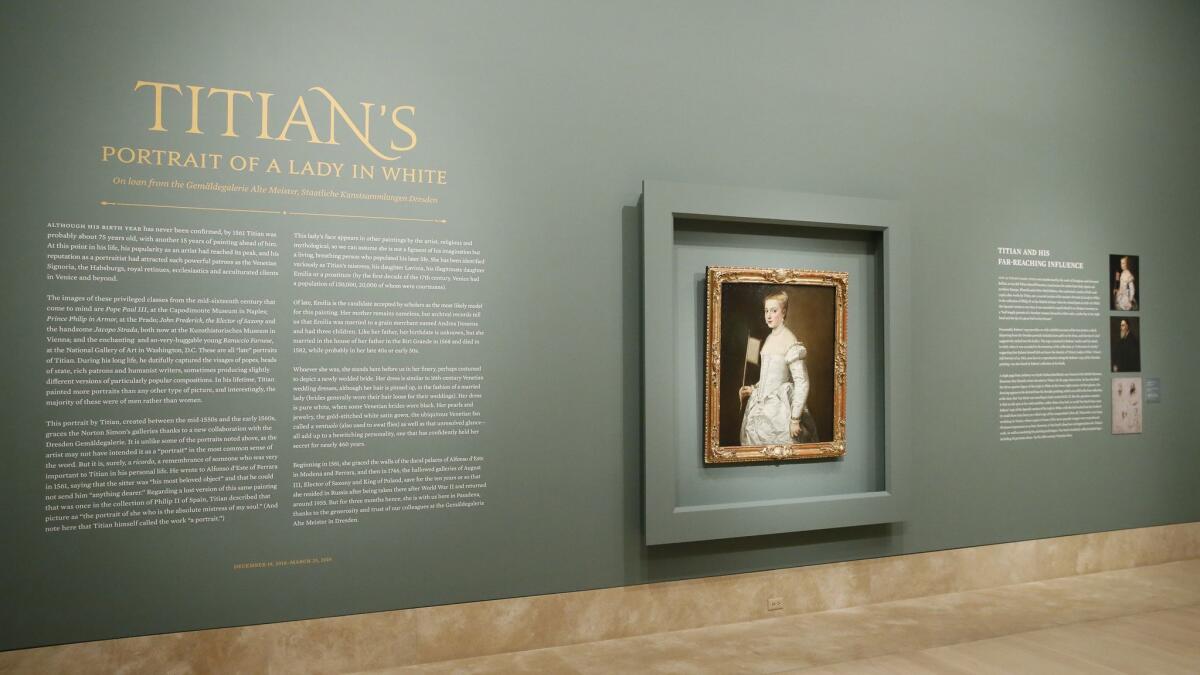Critic’s Notebook: Titian masterpiece comes to the Norton Simon: Why ‘Lady in White’ is worth seeing in living color

Titian’s knockout painting “Portrait of a Lady in White” might be misnamed. The three-quarter-length, roughly lifesize figure of a winsome but chaste young woman dressed in luxurious satin and dripping pearls is more accurately described as “Portrait of a Lady in Every Shade of White You Can Imagine — Plus, for Good Measure, a Bunch of Shimmering Golds.”
See for yourself at Pasadena’s Norton Simon Museum, where the splendid painting is on loan from Dresden’s State Art Collection, the Gemäldegalerie Alte Meister. It’s among Titian’s greatest portraits.
Color is always the Venetian painter’s calling card, and no Venetian was better at it than he. When that color is essentially limited to one — in this case, lead white — Titian fans the pigment out into a wide spread of tonalities, warm to cool.
Mostly the range of tones comes from the subtle addition of shades of gray, but sometimes faint hints of blue, yellow and earth-red can also be detected humming within the hues. Light-reflective white satin, semi-transparent white voile, pure white highlights on bracelets, the lustrous gleam of white pearls — even her gently rouged face, eyes shifted to the side to glance at a viewer, is best described as alabaster. The robust display lends monumentality to an otherwise delicate, even fragile image.
Gold helps.
Gold encircles the lady’s wrists, and it dots the white silk cord that encircles both her waist and the puffy sleeves at her shoulders. It decorates the handle and trim of the rectangular fan, called a ventuolo and distinctive to Venice, that she holds between the graceful fingers of her right hand. Gold threads edge the bodice and lacy trim on those sleeves.
Her hair is gold too, pulled back into a knot. The anonymous lady’s head might even be the light source that casts a burnished golden sheen behind her.
REVIEW: Sally Mann at the Getty »
The seemingly simple but truly elaborate composition is so stunning it was copied by more than one artist. Titian himself had painted an earlier version — now lost — for Philip II of Spain. Peter Paul Rubens copied that one, altering the lady’s face in ways suspiciously similar to the features of his beloved second wife, Helena Fourment. Now in Vienna’s Kunsthistorisches Museum, the Rubens is fine if more flamboyant, less magnetic.
The Titian underwent extensive conservation just over a decade ago. A deeply yellowed varnish that had long since obscured the stunning array of whites was stripped away. Just as dramatic, though, was the discovery that, at some point in its nearly 450-year lifespan, an earlier restoration had filled in the background with a nearly uniform plane of brown paint.
Conservators in Dresden, according to an essay produced at the time and newly translated into English, surmise that the over-painting was done to conceal damaged spots. A slight network of cracks had also formed over the years.
But Titian’s original ground was less a brown slab and more like toast – a modulated golden brown. Restored to the artist’s original modulated palette, the background is now characterized by subtle gradations of dark to light.
REVIEW: “Jeweled Isle” at LACMA »
The change had undercut an enchanting effect, causing what conservator Gunther Ohlhoff described as a figure that looked like “a cut-out” against an undifferentiated dark background. Now, mostly dark at the left, the direction in which the torso is turned, the contrast with the sumptuous white dress creates a vivid profile; and mostly light to the right, her body seems to be trailing radiance.
Filler it is not. (Never underestimate the critical role of a background.) The refined visual effect is remarkable, essential to the painting’s magic. This resplendent late portrait — painted around 1561, when the artist was in his 70s — demonstrates why Titian is credited among a handful of painters who created the foundations of a European pictorial tradition.
White does stand for purity, a social assignment of moral dimension, so the extravagant satin costume is assumed to be a magnificent wedding dress. However, more than a formal address to the symbolic life, which is certainly as significant as all those pearls that represent the abundance of the sea that gave Venice life and power, the demand the painting makes goes deeper.
Color floods the eye before the mind knows what hit it. Through color most of all, Titian’s art makes a direct appeal to the senses.
The lady in the portrait might be unknown today, the identity of the woman starring in such a stellar artistic achievement strangely lost to the shifting currents of time. (When Titian sent the canvas to Alfonso II d’Este, Duke of Ferrara, the elderly artist described her as “the most precious being” in his life — but he gave no name.) Once seen, however, the painting is unforgettable. That turns out to be enough.
♦ ♦ ♦ ♦ ♦ ♦ ♦ ♦ ♦ ♦
‘Portrait of a Lady in White’
Where: Norton Simon Museum, 411 W. Colorado Blvd., Pasadena
When: Through March 25; closed Tuesdays
Admission: $12-$15; 18 and younger free
Info: (626) 449-6840, nortonsimon.org
More to Read
The biggest entertainment stories
Get our big stories about Hollywood, film, television, music, arts, culture and more right in your inbox as soon as they publish.
You may occasionally receive promotional content from the Los Angeles Times.











